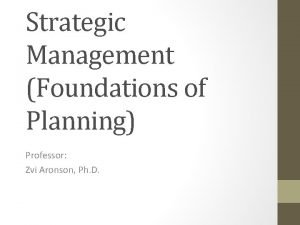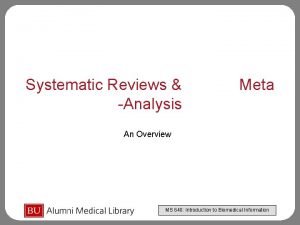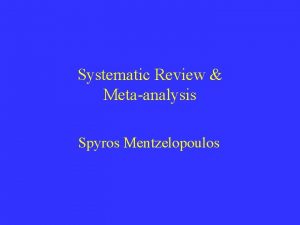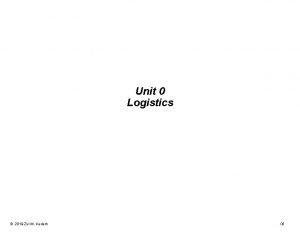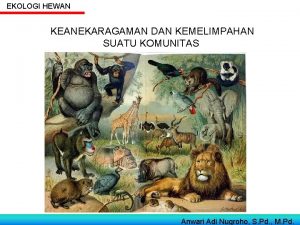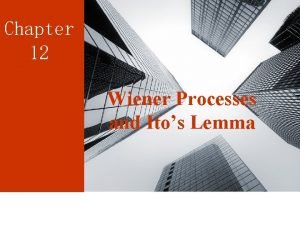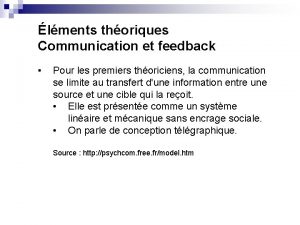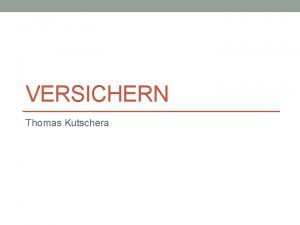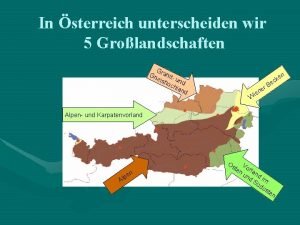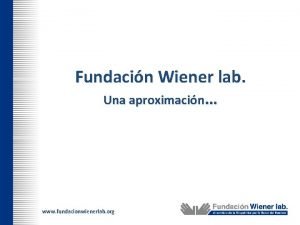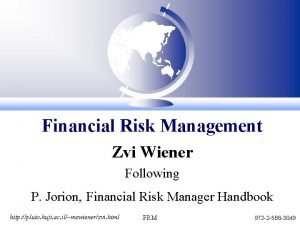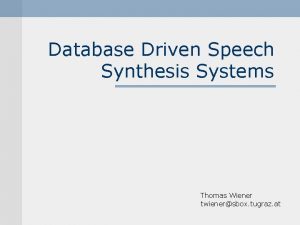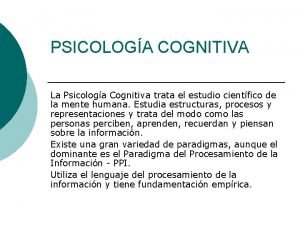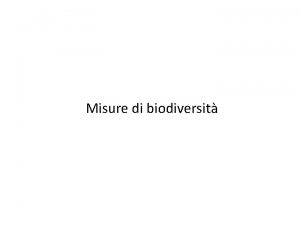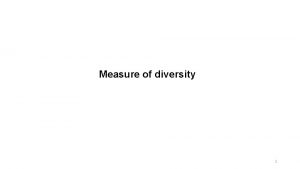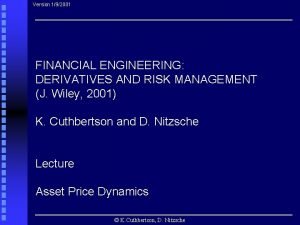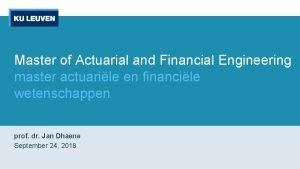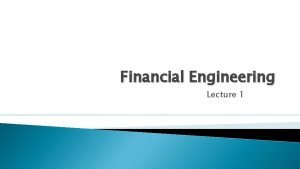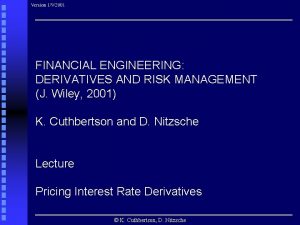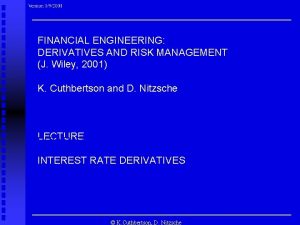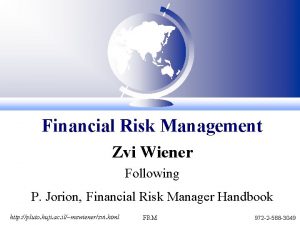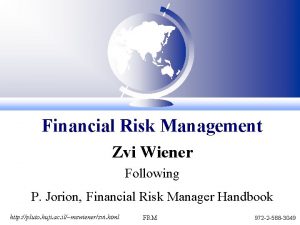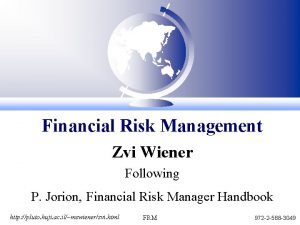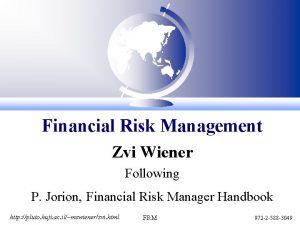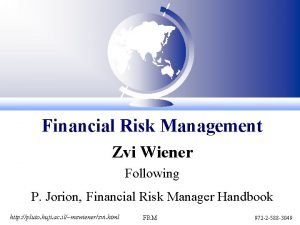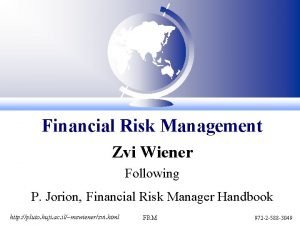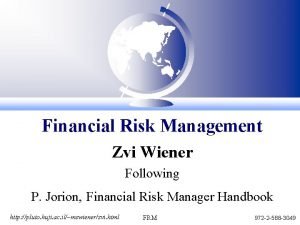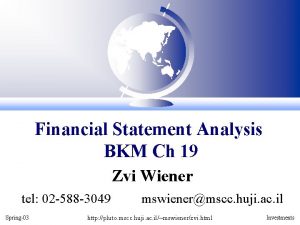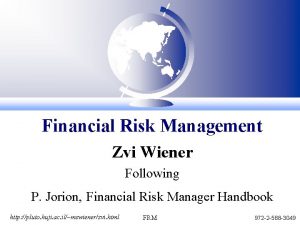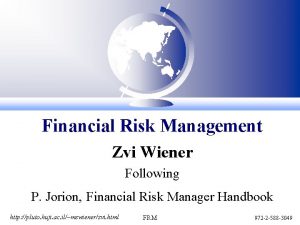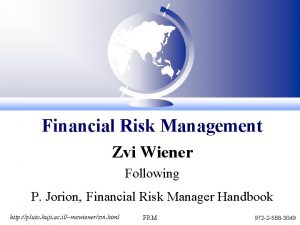Financial Engineering Zvi Wiener mswienermscc huji ac il



















































- Slides: 51

Financial Engineering Zvi Wiener mswiener@mscc. huji. ac. il 02 -588 -3049 FE-W http: //pluto. mscc. huji. ac. il/~mswiener/zvi. html EMBAF

Math Following Paul Wilmott, Introduces Quantitative Finance Chapter 4, see www. wiley. co. uk/wilmott FE-W http: //pluto. mscc. huji. ac. il/~mswiener/zvi. html EMBAF

e Natural logarithm 2. 71828459045235360287471352662497757… ex = Exp(x) e 0 = 1 e 1 = e Zvi Wiener FE-Wilmott-Intro. QF Ch 4 3

Exp(x) x Zvi Wiener FE-Wilmott-Intro. QF Ch 4 4

Ln Logarithm with base e. eln(x) = x, or ln(ex) = x Determined for x>0 only! Zvi Wiener FE-Wilmott-Intro. QF Ch 4 5

Ln Ln(x) Zvi Wiener FE-Wilmott-Intro. QF Ch 4 x 6

Differentiation and Taylor series f(x) x Zvi Wiener FE-Wilmott-Intro. QF Ch 4 7

Differentiation and Taylor series Zvi Wiener FE-Wilmott-Intro. QF Ch 4 8

Differentiation and Taylor series x Zvi Wiener FE-Wilmott-Intro. QF Ch 4 x+ x 9

Taylor series one variable Zvi Wiener FE-Wilmott-Intro. QF Ch 4 10

Taylor series two variable Zvi Wiener FE-Wilmott-Intro. QF Ch 4 11

Differential Equations Ordinary Partial Boundary conditions Initial Conditions Zvi Wiener FE-Wilmott-Intro. QF Ch 4 12

Chapter 2 Quantitative Analysis Fundamentals of Probability Following P. Jorion 2001 Financial Risk Manager Handbook FE-W http: //pluto. mscc. huji. ac. il/~mswiener/zvi. html EMBAF

Random Variables Values, probabilities. Distribution function, cumulative probability. Example: a die with 6 faces. Zvi Wiener FE-Wilmott-Intro. QF Ch 4 14

Random Variables Distribution function of a random variable X F(x) = P(X x) - the probability of x or less. If X is discrete then If X is continuous then Note that Zvi Wiener FE-Wilmott-Intro. QF Ch 4 15

Random Variables Probability density function of a random variable X has the following properties Zvi Wiener FE-Wilmott-Intro. QF Ch 4 16

Independent variables Credit exposure in a swap depends on two random variables: default and exposure. If the two variables are independent one can construct the distribution of the credit loss easily. Zvi Wiener FE-Wilmott-Intro. QF Ch 4 17

Moments Mean = Average = Expected value Variance Zvi Wiener FE-Wilmott-Intro. QF Ch 4 18

Its meaning. . . Skewness (non-symmetry) Kurtosis (fat tails) Zvi Wiener FE-Wilmott-Intro. QF Ch 4 19

Main properties Zvi Wiener FE-Wilmott-Intro. QF Ch 4 20

Portfolio of Random Variables Zvi Wiener FE-Wilmott-Intro. QF Ch 4 21

Portfolio of Random Variables Zvi Wiener FE-Wilmott-Intro. QF Ch 4 22

Product of Random Variables Credit loss derives from the product of the probability of default and the loss given default. When X 1 and X 2 are independent Zvi Wiener FE-Wilmott-Intro. QF Ch 4 23

Transformation of Random Variables Consider a zero coupon bond If r=6% and T=10 years, V = $55. 84, we wish to estimate the probability that the bond price falls below $50. This corresponds to the yield 7. 178%. Zvi Wiener FE-Wilmott-Intro. QF Ch 4 24

Example The probability of this event can be derived from the distribution of yields. Assume that yields change are normally distributed with mean zero and volatility 0. 8%. Then the probability of this change is 7. 06% Zvi Wiener FE-Wilmott-Intro. QF Ch 4 25

Quantile (loss/profit x with probability c) 50% quantile is called median Very useful in Va. R definition. Zvi Wiener FE-Wilmott-Intro. QF Ch 4 26

FRM-99, Question 11 X and Y are random variables each of which follows a standard normal distribution with cov(X, Y)=0. 4. What is the variance of (5 X+2 Y)? A. 11. 0 B. 29. 0 C. 29. 4 D. 37. 0 Zvi Wiener FE-Wilmott-Intro. QF Ch 4 27

FRM-99, Question 11 Zvi Wiener FE-Wilmott-Intro. QF Ch 4 28

FRM-99, Question 21 The covariance between A and B is 5. The correlation between A and B is 0. 5. If the variance of A is 12, what is the variance of B? A. 10. 00 B. 2. 89 C. 8. 33 D. 14. 40 Zvi Wiener FE-Wilmott-Intro. QF Ch 4 29

FRM-99, Question 21 Zvi Wiener FE-Wilmott-Intro. QF Ch 4 30

Uniform Distribution Uniform distribution defined over a range of values a x b. Zvi Wiener FE-Wilmott-Intro. QF Ch 4 31

Uniform Distribution 1 a Zvi Wiener b FE-Wilmott-Intro. QF Ch 4 32

Normal Distribution Is defined by its mean and variance. Cumulative is denoted by N(x). Zvi Wiener FE-Wilmott-Intro. QF Ch 4 33

Normal Distribution 66% of events lie between -1 and 1 95% of events lie between -2 and 2 Zvi Wiener FE-Wilmott-Intro. QF Ch 4 34

Normal Distribution Zvi Wiener FE-Wilmott-Intro. QF Ch 4 35

Normal Distribution symmetric around the mean = median skewness = 0 kurtosis = 3 linear combination of normal is normal 99. 99 99. 90 99 3. 715 3. 09 Zvi Wiener 97. 72 97. 5 2. 326 2. 000 1. 96 95 90 84. 13 1. 645 1. 282 1 FE-Wilmott-Intro. QF Ch 4 50 0 36

Lognormal Distribution The normal distribution is often used for rate of return. Y is lognormally distributed if X=ln. Y is normally distributed. No negative values! Zvi Wiener FE-Wilmott-Intro. QF Ch 4 37

Lognormal Distribution If r is the expected value of the lognormal variable X, the mean of the associated normal variable is r-0. 5 2. Zvi Wiener FE-Wilmott-Intro. QF Ch 4 38

Student t Distribution Arises in hypothesis testing, as it describes the distribution of the ratio of the estimated coefficient to its standard error. k - degrees of freedom. Zvi Wiener FE-Wilmott-Intro. QF Ch 4 39

Student t Distribution As k increases t-distribution tends to the normal one. This distribution is symmetrical with mean zero and variance (k>2) The t-distribution is fatter than the normal one. Zvi Wiener FE-Wilmott-Intro. QF Ch 4 40

Binomial Distribution Discrete random variable with density function: For large n it can be approximated by a normal. Zvi Wiener FE-Wilmott-Intro. QF Ch 4 41

FRM-99, Question 13 What is the kurtosis of a normal distribution? A. 0 B. can not be determined, since it depends on the variance of the particular normal distribution. C. 2 D. 3 Zvi Wiener FE-Wilmott-Intro. QF Ch 4 42

FRM-99, Question 16 If a distribution with the same variance as a normal distribution has kurtosis greater than 3, which of the following is TRUE? A. It has fatter tails than normal distribution B. It has thinner tails than normal distribution C. It has the same tail fatness as normal D. can not be determined from the information provided Zvi Wiener FE-Wilmott-Intro. QF Ch 4 43

FRM-99, Question 5 Which of the following statements best characterizes the relationship between normal and lognormal distributions? A. The lognormal distribution is logarithm of the normal distribution. B. If ln(X) is lognormally distributed, then X is normally distributed. C. If X is lognormally distributed, then ln(X) is normally distributed. D. The two distributions have nothing in common Zvi Wiener FE-Wilmott-Intro. QF Ch 4 44

FRM-98, Question 10 For a lognormal variable x, we know that ln(x) has a normal distribution with a mean of zero and a standard deviation of 0. 2, what is the expected value of x? A. 0. 98 B. 1. 00 C. 1. 02 D. 1. 20 Zvi Wiener FE-Wilmott-Intro. QF Ch 4 45

FRM-98, Question 10 Zvi Wiener FE-Wilmott-Intro. QF Ch 4 46

FRM-98, Question 16 Which of the following statements are true? I. The sum of normal variables is also normal II. The product of normal variables is normal III. The sum of lognormal variables is lognormal IV. The product of lognormal variables is lognormal A. I and II B. II and III C. III and IV D. I and IV Zvi Wiener FE-Wilmott-Intro. QF Ch 4 47

FRM-99, Question 22 Which of the following exhibits positively skewed distribution? I. Normal distribution II. Lognormal distribution III. The returns of being short a put option IV. The returns of being long a call option A. II only B. III only C. II and IV only D. I, III and IV only Zvi Wiener FE-Wilmott-Intro. QF Ch 4 48

FRM-99, Question 22 C. The lognormal distribution has a long right tail, since the left tail is cut off at zero. Long positions in options have limited downsize, but large potential upside, hence a positive skewness. Zvi Wiener FE-Wilmott-Intro. QF Ch 4 49

FRM-99, Question 3 It is often said that distributions of returns from financial instruments are leptokurtotic. For such distributions, which of the following comparisons with a normal distribution of the same mean and variance MUST hold? A. The skew of the leptokurtotic distribution is greater B. The kurtosis of the leptokurtotic distribution is greater C. The skew of the leptokurtotic distribution is smaller D. The kurtosis of the leptokurtotic distribution is smaller Zvi Wiener FE-Wilmott-Intro. QF Ch 4 50

Home Assignment Read chapters 4, 5 in Wilmott. Read and understand the xls files!! Build a module for pricing of the Max, Min and Mixture programs (BRIRA). Analyze the program offered by BH. Build a module for pricing of this program. Describe in terms of options the client’s position in the program offered by FIBI. Zvi Wiener FE-Wilmott-Intro. QF Ch 4 51
 Zvi wiener
Zvi wiener Zvi wiener
Zvi wiener Zvi wiener
Zvi wiener Zvi aronson
Zvi aronson Andrea reger
Andrea reger Zvi margaliot
Zvi margaliot Zvi margaliot
Zvi margaliot Zvi aronson
Zvi aronson Zvi kedem
Zvi kedem Dr zvi margaliot
Dr zvi margaliot Zvi roth
Zvi roth Wiener schlosserbuben
Wiener schlosserbuben Wiener laufcup
Wiener laufcup Rumus indeks simpson
Rumus indeks simpson Craig wiener md
Craig wiener md Generalized wiener process
Generalized wiener process Wiener liste antibiotika
Wiener liste antibiotika Modèle de jakobson communication
Modèle de jakobson communication Wiener tafelspitz beilagen
Wiener tafelspitz beilagen Thomas kutschera
Thomas kutschera Wiener rh-hr terminology
Wiener rh-hr terminology Historischer hintergrund weimarer klassik
Historischer hintergrund weimarer klassik Diese landeshauptstadt liegt im vorland im südosten
Diese landeshauptstadt liegt im vorland im südosten Fundacion wiener cursos a distancia
Fundacion wiener cursos a distancia Wiener
Wiener Wiener
Wiener Wiener salon gulasch
Wiener salon gulasch Thomas wiener
Thomas wiener Normtabelle
Normtabelle Wiener anerkennungssystem
Wiener anerkennungssystem Wiener rh-hr terminology
Wiener rh-hr terminology Reputable isri scrap recycler
Reputable isri scrap recycler Modelo de wiener
Modelo de wiener Equitabilità
Equitabilità Community
Community Advantages and disadvantages of shannon diversity index
Advantages and disadvantages of shannon diversity index Wiener kreis
Wiener kreis Wiener verein bedingungen
Wiener verein bedingungen Non financial method of motivation
Non financial method of motivation Financial engineering notes
Financial engineering notes Financial engineering derivatives and risk management
Financial engineering derivatives and risk management Actuarial and financial engineering
Actuarial and financial engineering Financial engineering syllabus
Financial engineering syllabus Conceptual tools of financial engineering
Conceptual tools of financial engineering Financial engineering derivatives and risk management
Financial engineering derivatives and risk management Financial engineering derivatives and risk management
Financial engineering derivatives and risk management System architecture example
System architecture example Forward engineering in software engineering
Forward engineering in software engineering Dicapine
Dicapine Elegant systems
Elegant systems Forward and reverse engineering
Forward and reverse engineering Pshe financial education
Pshe financial education



